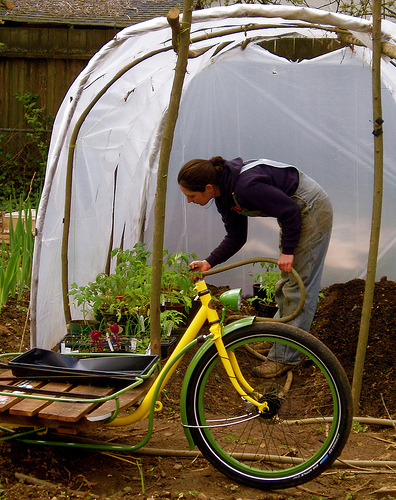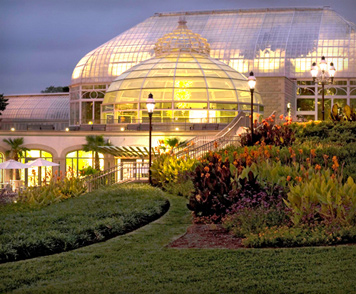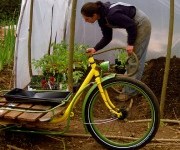 Photo: MetrofietsI stepped out onto my front porch one day this summer just in time to see my farmer pedaling down the street with a trailer full of tools.
Photo: MetrofietsI stepped out onto my front porch one day this summer just in time to see my farmer pedaling down the street with a trailer full of tools.
To an outsider, such a vision must seem like a sketch right out of Portlandia, the television show that spoofs my hometown’s supposedly eccentric ways. Here in real-world Portland, however, it’s a normal sight. The farm from which I get most of my vegetables, aptly named Sidewalk’s End, is one of several local examples of something called “dispersed urban agriculture.” Rather than farming all in one place, the two young farmers who run Sidewalk’s End, Holly Mills and Caitlin Arnold, cultivate five urban backyards around southeast Portland. To get from one to the next, they often use bikes.
I subscribed to their CSA (community-supported agriculture) program this summer because the pickup point is an easy one-mile bike ride from my house. I paid an annual fee for my share of the farm’s harvest. Other CSA members get their food in exchange for letting Mills and Arnold farm in their yards. One yard is entirely planted with garlic; another is a seed testing site.
It would be easy to take farming by bike as a sign that dear old Portland has jumped the (locavore) shark. I called up Mills to ask about the hows and whys of bike farming.
It turns out that being green is, as I suspected, behind every decision made at Sidewalk’s End, Mills said, from their dispersed urban model to the sturdy “apocalypticrops” they grow.
Biking is no exception. Strictly eating food from 100 or 50 miles away, as many in Portland’s burgeoning local food movement do, “is a lot more awesome than shipping it from another hemisphere,” Mills said. “But even shipping it 50 miles in a truck every week — that’s a lot of fuel.”
Sidewalk’s End’s unconventional methods have proven to make good economic sense, and not just from a marketing perspective.
“If I was going to start a farm in the traditional way,” Mills explained, “I probably would have started with a saved-up nest egg and spent a year building the infrastructure.” Instead, the farmers launched their operations with $1,000 — not even enough to invest in a reliable truck.
“We looked at the resources we already had,” Mills said. “We’re scrappy and have a lot of energy and ride bikes and are already good at moving a lot of stuff around by bike. We get things for free on Craigslist or from dumpsters or for trade. As young farmers with very few resources, it made sense to start where we lived” — in the city rather than the country — “and with the infrastructure we already had.”
Their skimping has paid off. Sidewalk’s End has “totally broken even” both years, Mills said, with the farmers earning enough to cover all their expenses for the season and having the same amount saved up to cover the next season. These costs don’t include labor — both farmers work other jobs for money. But if all goes as planned, they’ll be able to pay themselves sooner than if they’d started out with a lot of debt.
That isn’t to say that the path they’ve chosen is easy. “The transportation is definitely a logistical work in progress,” Mills said, requiring high levels of organization and efficiency. To organize it all, she said, “I do lists. Lots of lists. I have a map in my head — it’s kind of like a video game. This garden is on the way to this other garden, and I need to get here early to water and then on to another place to prune and then another one to weed. It’s very thrilling.”
Even so, Sidewalk’s End is in the market for a truck. “This fall, we are starting a new garden, which means building a sheet mulch, which means a lot of manure,” Mills said. “I don’t know how I would do that without a truck unless we were able to generate all our own compost — which we don’t have room for yet.”
Mills and Arnold are not giving up on their bikes, though. Mills plans to attend a bike building workshop this year so she can craft a bamboo cargo bike better suited to carrying loads of tools and compost.
They’ve learned a lot in two years and plan to ease their logistics by making their operations even more local. Mills hopes that extra outreach efforts will enable them to consolidate their plots to a more neighborhood scale, closer to their home. Their operations are very much a work in progress. “There are other farmers that have done the bike farming more efficiently than we do,” Mills said, “and I’m really curious about how they do that.”
Mills and Arnold are among those working out an alternative agricultural model, one that relies on backyards instead of mega-corporations. The strength of this big vision, though, is in its small scale and slow growth. “We can’t try and act like we’re a big farm, ’cause we aren’t,” Mills said. “We move slowly and can only carry so many things and can’t buy and build a lot of infrastructure.
“In a good way, it keeps us humble.”




